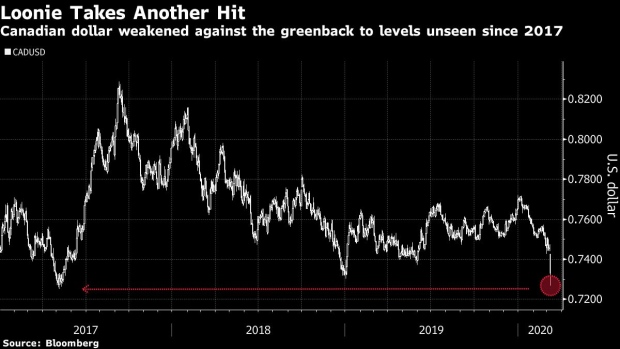Mar 9, 2020
Biggest Drop Since 1987 Crash: Canada Stocks Plunge on Oil Woes
, Bloomberg News

(Bloomberg) -- Canadian markets were battered on all fronts as the collapse in oil sent shockwaves through a country with one of the biggest exposures to the commodity among the Group of Seven.
Stocks cratered 10% with the biggest drop since October 1987, the loonie weakened and government bond yields plunged to fresh records as investor pessimism deepened for an economy that barely eked out any growth in the fourth quarter and is already grappling with the coronavirus.
The slump in oil will exact another heavy toll on the natural resource-dependent country, which generates about 9% of its gross domestic product from energy and has the biggest exposure to the sector on its stock market at 15%.
The S&P/TSX Composite Index hit a circuit breaker after sliding almost 9% and fell further to 10% when trading reopened. The benchmark was down 7.2% as of 10:03 a.m, on pace for its biggest drop since December 2008.
“The oil price crash will do irreparable damage to the Canadian economy and stock market,” said Ed Moya, a senior market analyst at Oanda Corp. in New York. “Canadians will have to brace for lower prices for the foreseeable future and the oil sector will have to consolidate. Even when virus fears ease, the oil-dependent Canadian economy snapback rally will lag their peers,” he said.
The loonie plunged 1.3% against the greenback as of 10 a.m. West Texas Intermediate, the North American benchmark, was down 20% after tumbling as much as 34% in the biggest descent since March 1983.
“The Canadian dollar is embattled with risks to already weak economic growth coming from all angles,” Simon Harvey a London-based market analyst at Monex Europe Ltd. and Monex Canada Inc., said by email. “Markets are coming to the realization that rate cuts by the Bank of Canada will soon lose their effectiveness on supporting the economy, especially with the latest risk of a lower oil price for longer.”
Harvey sees the loonie falling further away from the C$1.30 area if the oil-price rout is sustained while Bipan Rai, North American head of FX strategy at Canadian Imperial Bank of Commerce expects the C$1.40 to breached in the the next two quarters.
The loonie “needs to weaken further given the high degree of oil exports as a percentage of Canada’s goods exports,” Rai said. U.S. dollar “bulls may require some patience as price action is overbought, but ‘buy the dip’ is still the right strategy for” the dollar-loonie currency pair.
With the Canadian dollar’s correlation to oil prices, it’s bound to keep weakening.
“The currencies of any country for which the oil sector is a significant growth generator are having an awful day and won’t stabilize until oil finds a bottom,” said Kit Juckes, a strategist at Societe Generale SA, said in an email Monday.The loonie “is likely to underperform the Australia and New Zealand dollars for example, as long as oil prices are falling.
The yield on Canada’s 10-year benchmark fell to as low as 0.225% on Monday and the five-year note hit 0.276%, according to Bloomberg data. Traders are now betting on the Bank of Canada, which last week lowered its policy rate to 1.25%, to cut another 50 basis points by its next scheduled meeting in April and another 25 basis points by July.
(Updates throughout with market open.)
To contact the reporters on this story: Jacqueline Thorpe in Toronto at jthorpe23@bloomberg.net;Divya Balji in Toronto at dbalji1@bloomberg.net;Susanne Barton in New York at swalker33@bloomberg.net
To contact the editors responsible for this story: Derek Decloet at ddecloet@bloomberg.net, Stephen Wicary
©2020 Bloomberg L.P.


